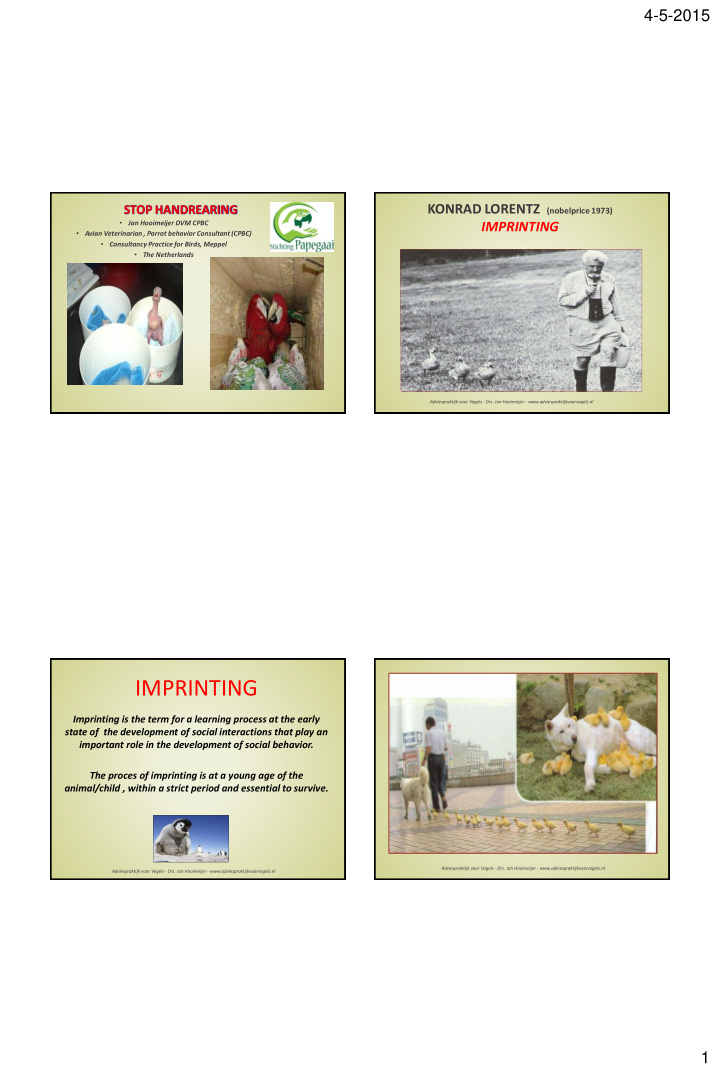



4-5-2015 KONRAD LORENTZ (nobelprice 1973) STOP HANDREARING • Jan Hooimeijer DVM CPBC IMPRINTING • Avian Veterinarian , Parrot behavior Consultant (CPBC) • Consultancy Practice for Birds, Meppel • The Netherlands Adviespraktijk voor Vogels - Drs. Jan Hooimeijer - www.adviespraktijkvoorvogels.nl IMPRINTING Imprinting is the term for a learning process at the early state of the development of social interactions that play an important role in the development of social behavior. The proces of imprinting is at a young age of the animal/child , within a strict period and essential to survive. Adviespraktijk voor Vogels - Drs. Jan Hooimeijer - www.adviespraktijkvoorvogels.nl Adviespraktijk voor Vogels - Drs. Jan Hooimeijer - www.adviespraktijkvoorvogels.nl 1
4-5-2015 Animal Law BIZARRE!! Determined at what age a young animal may be seperated from the mother: • Dog = 7 weeks • Cat = 7 weeks • Rabbit = 4 weeks • Chimpansee = 4 years • Parrots have to eat completely independent since July 1th 2014 Adviespraktijk voor Vogels - Drs. Jan Hooimeijer - www.adviespraktijkvoorvogels.nl WHAT IS THE PROBLEM WITH HANDREARING? WHY HANDREARING? • Imprinting towards humans. • Behaviour problems: more insecure, fear/phobic behaviour, biting, featherpicking, • Compensation of managementfailures! hormonal behaviour. It may take months and (Malnutrition, Stressfactors, Not tame, No name) years to develop! • Problem as breeding bird. • Less viable birds survive. • Females will lay more eggs! $$$ • More eggs / baby’s is not in the best interest of the female • Negative effect on the female, producing more and not in the best interest of the baby’s. eggs than normal egg quality- life expectancy • Just $$$$$ is low. • Breeding with breeding pairs that do not raise their own yougsters. 2
4-5-2015 WHY TRADE IN UNWEANED BABY PREVENT IMPRINTING PARROTS? • Birds become more tame, less behaviour problems? • No way = Sales pitch! CALIFORNIAN CONDOR PROJECT • Selling young profitable, less risk for seller $$$ NO HUMAN CONTACT WHEN HANDREARING IS NEEDED. ROLE OF AVICULTURE THE OUTCOME OF LIVING IN CAPTIVITY, HAND REARED AND Most birds in aviculture ” LOVED ”. show behaviour problems; • No name, not tame • The number of Moluccan • Fear, stress Cockatoos in parrot rescue • Lack of trust having severe behaviour problems is bigger than the • Hand rearing!! population in nature. • Malnutrition!! • Lack of exercise • Cage factor!!! Dog in kennel!? • How more sad can it be? 3
4-5-2015 TAME BREEDING BIRDS ARA MAKING WHAT ARE THE NAMES OF YOUR BREEDING BIRDS? A HUGE DIFFERENCE Thank you for your attention Consultancy Practice for Birds Drs. Jan Hooimeijer info@vogeladvies.nl 4
Recommend
More recommend